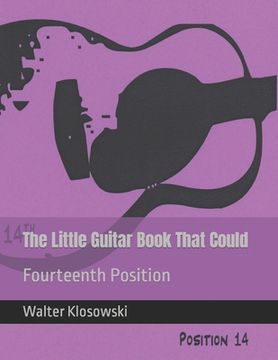Synopsis "The Little Guitar Book That Could: Fourteenth Position"
This LITTLE GUITAR BOOK THAT COULD showcases the C A G E D chord and scale sequence exclusively in the FOURTEENTH POSITION, for all to see and use. But, before thumbing through this book, there's some subject matter that the guitarist may need reminding of...even though he or she may have played for years. For example, in this book, six is the exact number of consecutive frets involved in the FOURTEENTH POSITION, and each guitar position spans a full two octaves plus a perfect fourth when in standard tuning. Also, when in this guitar position the second and third fingers on the fretting hand are to remain stationary in their respective frets or "slots", initially, as their stationary qualities allow the first and or fourth finger to stretch or slide to those notes in the outermost frets. As for the picking hand, a very useful and important picking pattern occurs down by the sound hole or bridge where the picking hand spends a majority of its time. This picking pattern involves every other string and is best evidenced when the center most root notes, or main root notes, in the FOURTEENTH POSITION are plucked alphabetically, starting with the G root note located on the first or thinnest guitar string. The specific string picking pattern begins by picking the G root there (first string, second finger); then A (third string, first finger); C (fifth string, second finger); D (second string, second finger); E (fourth string, first finger) and conclude with the G (sixth string, second finger). The one-three-five, two-four-six string pattern naturally fits the picking hand and is looped, forwards or backwards (six-four-two, five-three-one) as the G root notes found on the first / sixth string(s) are interchangeable. That said, there are three additional terms that need some brief clarification for the purposes of THE LITTLE GUITAR BOOK THAT COULD...those being main root notes, octaves and unisons. What are main root notes? Generally speaking, main root notes represent a specific set of root notes that fall or cluster under the second and third fingers of the fretting hand, in the heart of the position itself. However, there are two instances in the FOURTEENTH POSITION where the main root notes are played using the first and fourth fingers, both of which are an exception of sorts and just as valid. Please be aware of this. Once the placement of each C A G E D main root note is memorized, the attention then moves to their octaves. Octaves are defined as the interval between one musical pitch and another with half or double its own frequency. Some correctly call the interval a "perfect octave", and in guitarland, octaves are usually "one string one fret away". This handy fact helps memorize their location even though, occasionally, two strings and or two frets are involved (the same concept applies in that there will be some sort of string skipping.) The last musical term to be discussed is the term unisons, which are defined when two or more music notes happen to sound the exact same pitch. In guitarland, it usually means "same note different string or fret", and the term implies that the unison occurs in the guitar position at hand. So that's it! This LITTLE GUITAR BOOK THAT COULD for the FOURTEENTH POSITION remains uncomplicated, straightforward and very practical to use. Its visual based "picture worth a thousand words" format allows one to take full advantage of the documented guitar material right away. You'll have fun discovering some fresh perspectives on the same old technical effort, while also adding some new twists and turns to your own fingering technique. Plus, THE LITTLE GUITAR BOOK THAT COULD for the FOURTEENTH POSITION also contains copious amounts of manuscript and fretboard paper too!...plenty to jot down or journal your musical ideas. To close, thank you very kindly for including THE LITTLE GUITAR BOOK THAT COULD in your library repertoire of fretboard knowledge needs...and as always...enjo

